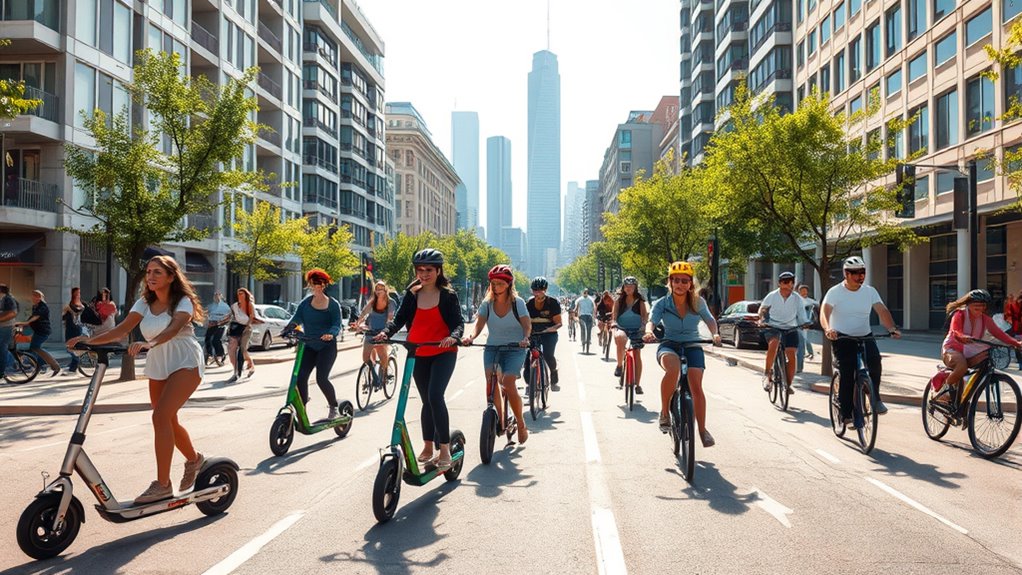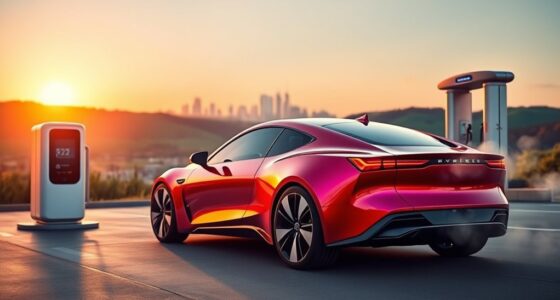Micromobility, including e-scooters and e-bikes, is revolutionizing how you navigate cities. These electric vehicles make short trips quicker and more fun, reducing car reliance and traffic congestion. They’re easy to rent with a smartphone app, offering an eco-friendly alternative that cuts down air pollution. Plus, urban planning is evolving with better bike lanes and parking, making your journey safer and more enjoyable. Discover how this trend shapes healthier, more sustainable urban living.
Key Takeaways
- Micromobility options like e-scooters and e-bikes provide convenient, efficient alternatives for short urban trips, reducing car dependency.
- Users can easily rent e-scooters and e-bikes through smartphone apps, enhancing the practicality of city travel.
- Electric micromobility contributes to lower greenhouse gas emissions and promotes cleaner air in urban areas.
- Cities are investing in infrastructure, such as bike lanes and designated parking, to support the growing micromobility trend.
- The rise of micromobility fosters a cultural shift towards sustainable, active transportation and healthier urban living.

Have you ever considered how micromobility is reshaping urban transportation? As cities grow and traffic congestion worsens, you might find that e-scooters and e-bikes are becoming more than just trendy alternatives; they’re revolutionizing the way you get around. These small, electric vehicles are part of a shift in urban infrastructure, making it easier and more efficient for you to navigate your surroundings without relying solely on cars or public transit.
Micromobility solutions are designed for the short trips that often plague urban dwellers. With just a few taps on your smartphone, you can rent an e-scooter or e-bike and zip through the city, bypassing traffic jams and lengthy waits for buses or trains. This convenience not only saves time but also encourages you to explore your neighborhood in a way that’s both enjoyable and practical. As you ride, you’re likely to notice how these options are transforming once car-dominated streets into spaces that prioritize people over vehicles.
The environmental impact of micromobility can’t be overlooked. Every time you choose an e-scooter or e-bike instead of driving, you’re contributing to reduced greenhouse gas emissions and lessening air pollution. Cities are increasingly recognizing that integrating these modes of transport into their urban infrastructure can lead to cleaner air and a healthier populace. By replacing short car trips with electric rides, you’re playing a part in the larger movement towards sustainable urban living. Furthermore, some cities are implementing solar panels for camping in public spaces to promote eco-friendly practices and enhance the sustainability of urban transport.
Moreover, the rise of micromobility has led cities to rethink their planning strategies. You’ve probably noticed more bike lanes and designated scooter parking popping up around town. This evolution in urban infrastructure not only accommodates the growing number of micromobility users but also enhances safety for riders and pedestrians alike. These improvements create a more inviting atmosphere for everyone, fostering a culture where walking, biking, and scooting are encouraged.
In essence, micromobility represents a shift in how we view transportation within urban settings. As you embrace these new options, you’re not just making your daily commute easier; you’re also helping to pave the way for a more sustainable future. So next time you step outside, consider hopping on an e-scooter or e-bike. You might just discover a fun, efficient, and eco-friendly way to navigate your city.
Frequently Asked Questions
What Is the Cost of Renting E-Scooters and E-Bikes?
Renting e-scooters and e-bikes typically costs between $1 to $3 to activate, plus $0.15 to $0.50 per minute. Some companies offer subscription plans, allowing you to pay a monthly fee for unlimited rides or discounted rates. Pricing models can vary based on the city and provider, so it’s smart to check local options. Always look for promotions or deals to make your rides more affordable while exploring the city!
Are E-Scooters and E-Bikes Safe to Use?
E-scooters and e-bikes can be safe to use if you follow some basic guidelines. Always wear a helmet for safety; it substantially reduces the risk of head injuries in case of an accident. Stick to bike lanes where possible, stay aware of your surroundings, and obey traffic rules to prevent accidents. By taking these precautions, you can enjoy your ride while minimizing risks and ensuring a safer experience on the road.
What Are the Age Restrictions for Riding Micromobility Devices?
Most places have age restrictions for riding micromobility devices, typically requiring riders to be at least 16 or 18 years old. Some areas might even enforce additional licensing requirements, especially for e-bikes that exceed certain speed limits. Before you hop on, check local regulations to guarantee you meet the age and licensing criteria. It’s important to stay informed to ensure your ride is both fun and compliant with the law!
How Do I Find Charging Stations for E-Bikes?
Finding charging stations for your e-bike is easier than you might think. Just imagine cruising through a city with a network of e-bike stations at your fingertips. You can use mobile apps like ChargePoint or specific e-bike networks to locate nearby charging stations. Many cities also have dedicated maps online, showing you where to plug in. Don’t forget to check for public parks or cafes that might offer charging options too!
Can E-Scooters and E-Bikes Be Used in Bad Weather?
Yes, you can use e-scooters and e-bikes in bad weather, but you should consider weather conditions carefully. Rain, snow, or icy surfaces can affect traction and braking, increasing the risk of accidents. Check your device’s durability; many models are designed to handle wet conditions, but not all are waterproof. It’s wise to ride cautiously, wear appropriate gear, and avoid using these devices in extreme weather to stay safe.
Conclusion
Ultimately, micromobility is revolutionizing urban travel, making it more accessible and sustainable. Did you know that e-scooters and e-bikes can reduce carbon emissions by up to 50% compared to traditional vehicles? With their convenience and eco-friendliness, these modes of transport are not just a trend; they’re shaping the future of city commuting. So, next time you’re considering how to get around, think about hopping on an e-scooter or e-bike and join the movement!










